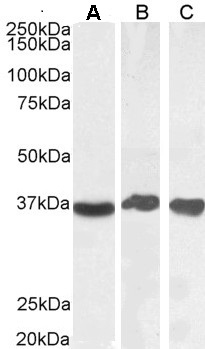GAPDH antibody [GT239]
GTX627408
ApplicationsImmunoFluorescence, Western Blot, ImmunoCytoChemistry, ImmunoHistoChemistry, ImmunoHistoChemistry Paraffin, Other Application
Product group Antibodies
TargetGAPDH
Overview
- SupplierGeneTex
- Product NameGAPDH antibody [GT239]
- Delivery Days Customer9
- Application Supplier NoteWB: 1:500-1:20000. ICC/IF: 1:100-1:1000. IHC-P: 1:100-1:1000. *Optimal dilutions/concentrations should be determined by the researcher.Not tested in other applications.
- ApplicationsImmunoFluorescence, Western Blot, ImmunoCytoChemistry, ImmunoHistoChemistry, ImmunoHistoChemistry Paraffin, Other Application
- CertificationResearch Use Only
- ClonalityMonoclonal
- Clone IDGT239
- Concentration1 mg/ml
- ConjugateUnconjugated
- Gene ID2597
- Target nameGAPDH
- Target descriptionglyceraldehyde-3-phosphate dehydrogenase
- Target synonymsG3PD, GAPD, HEL-S-162eP, glyceraldehyde-3-phosphate dehydrogenase, OCAS, p38 component, Oct1 coactivator in S phase, 38 Kd component, aging-associated gene 9 protein, epididymis secretory sperm binding protein Li 162eP, peptidyl-cysteine S-nitrosylase GAPDH
- HostMouse
- IsotypeIgG2b
- Protein IDP04406
- Protein NameGlyceraldehyde-3-phosphate dehydrogenase
- Scientific DescriptionThe product of this gene catalyzes an important energy-yielding step in carbohydrate metabolism, the reversible oxidative phosphorylation of glyceraldehyde-3-phosphate in the presence of inorganic phosphate and nicotinamide adenine dinucleotide (NAD). The enzyme exists as a tetramer of identical chains. Many pseudogenes similar to this locus are present in the human genome. [provided by RefSeq]
- Storage Instruction-20°C or -80°C,2°C to 8°C
- UNSPSC12352203
References
- Jahin I, Phillips T, Marcotti S, et al. Extracellular matrix stiffness activates mechanosensitive signals but limits breast cancer cell spheroid proliferation and invasion. Front Cell Dev Biol. 2023,11:1292775. doi: 10.3389/fcell.2023.1292775Read this paper
- Binh DHN, Cheng TC, Tu SH, et al. StAR-related lipid transfer domain protein 3 (STARD3) regulates HER2 and promotes HER2-positive breast cancer progression through interaction with HSP90 and SRC signaling. Am J Cancer Res. 2023,13(11):5151-5173.Read this paper
- St-Denis-Bissonnette F, Cummings SE, Qiu S, et al. A clinically relevant large-scale biomanufacturing workflow to produce natural killer cells and natural killer cell-derived extracellular vesicles for cancer immunotherapy. J Extracell Vesicles. 2023,12(12):e12387. doi: 10.1002/jev2.12387Read this paper
- Heo H, Park H, Lee MS, et al. TRIM22 facilitates autophagosome-lysosome fusion by mediating the association of GABARAPs and PLEKHM1. Autophagy. 2024,20(5):1098-1113. doi: 10.1080/15548627.2023.2287925Read this paper
- Schmidt S, Stautner C, Vu DT, et al. A reversible state of hypometabolism in a human cellular model of sporadic Parkinson's disease. Nat Commun. 2023,14(1):7674. doi: 10.1038/s41467-023-42862-7Read this paper
- Hansen FM, Kremer LS, Karayel O, et al. Mitochondrial phosphoproteomes are functionally specialized across tissues. Life Sci Alliance. 2024,7(2). doi: 10.26508/lsa.202302147Read this paper
- Hu CM, Huang CC, Hsu MF, et al. Oncogenic KRAS, Mucin 4, and Activin A-Mediated Fibroblast Activation Cooperate for PanIN Initiation. Adv Sci (Weinh). 2023,10(36):e2301240. doi: 10.1002/advs.202301240Read this paper
- Power AS, Asamudo EU, Worthington LPI, et al. Nitric Oxide Modulates Ca(2+) Leak and Arrhythmias via S-Nitrosylation of CaMKII. Circ Res. 2023,133(12):1040-1055. doi: 10.1161/CIRCRESAHA.123.323571Read this paper
- Garcia JD, Wolfe SE, Stewart AR, et al. Distinct mechanisms drive sequential internalization and degradation of GABA(A)Rs during global ischemia and reperfusion injury. iScience. 2023,26(10):108061. doi: 10.1016/j.isci.2023.108061Read this paper
- Zhang A, Lau NA, Wong A, et al. Concurrent Targeting of HDAC and PI3K to Overcome Phenotypic Heterogeneity of Castration-resistant and Neuroendocrine Prostate Cancers. Cancer Res Commun. 2023,3(11):2358-2374. doi: 10.1158/2767-9764.CRC-23-0250Read this paper








